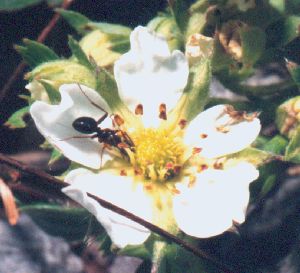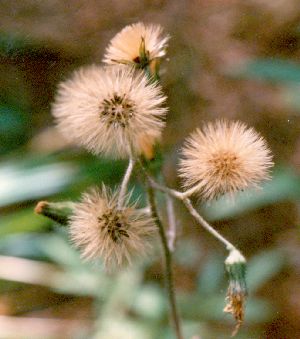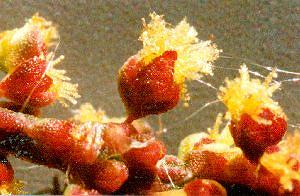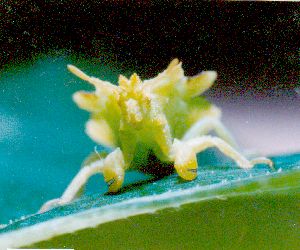Grow a Back Yard Meadow
My meadow year starts in March, with snow still deep under the hedge - a sprinkling of brilliant yellow crocus. By the end of May, with the first iris, there is yellow all over, from oxalis, buttercups and yellow clovers. Two weeks later, the white of bladder campion and wood anemone predominates. Then, sprays of white melilot rise to hang over a carpet of yellow trefoil. Exploring with a magnifying glass, the sculptured elegance of bugleweed and the precise world of grass flowers come to light. To end the year, there are waves of glorious yellow goldenrods, then mounds of white and blue asters.
With understanding far beyond that of ourselves, nature abhors simplicity. My yard is small, and I only have 10 square metres for a meadow. Even so, I have been able to identify 160 different plants living there. Some flowers are only a millimetre across. Some hug the ground, others spread a metre up. Some, with fat yellow anthers, delight in the wind. Some live in partnership with tiny hoverflies, some with ants, others with bumblebees. All accept the adversity of nature as well as its bounty, some with stout perennial roots, others with seed that can live for years before germinating.
If you would join me, here are a few guidelines.
Plants are living things. They have neighbours, form communities. No one who cares for them will destroy them by overcollection, or move them to a location where they cannot survive. So, to start my meadow off I collected only seeds of plants that were growing wild, close to my home, in abundance, in environments where soil moisture, light level and plant community were similar to my back yard patch. Then, I turned over a clod of earth with a shovel, scattered the seeds on the exposed earth, and stomped it flat. If plants belong in my meadow, they grow. The genetic diversity provided by seeds helps to establish a healthy population in a meadow. Collecting only a few seeds ensures that plants continue to survive in the wild. Once a biodiverse meadow is established, you need collect seeds no longer - the successful plants will maintain themselves in variety. After ten years, I still see about a hundred species flower each year. It is only in unnatural, botanically impoverished, environments that one species 'takes over'.
It is worth correcting a common misconception here - that a biodiverse habitat such as my meadow automatically prevents alien species from joining them. That is only partially true - some alien species will indeed be able to survive there. But, they will only survive as part of the community. My daffodils, and several similar spring bulbs, are still blooming happily after ten years there. But, I almost never see a dandelion!
I recommend that you avoid collecting plants that are rare in your area. If a plant is rare, it's usually because it doesn't belong there, for climate, soil or other reasons. It's much better to celebrate the success of the many plants that do belong in your environment - they are the species that truly maintain biodiversity around you. (Basing habitat preservation policies on rare species counts is a common error made by both specialists and bureaucrats. Specialists make it because of life's instinctual attention for the unusual and filtering out of the ordinary; bureaucrats from their fetish of putting one number on things in the erroneous belief that this results in 'rational' decision making. To nature there is no such thing as an 'endangered' or 'common' species - if it lives, it's OK, if it doesn't, it isn't.)
At one end of my meadow, I have a small pond. A water lily, a small goldfish, and a few jars of water collected from healthy cattail-filled ditches to start it off, have combined to make a fascinatingly rich community of water creatures. But, no mosquitoes - the goldfish eats the larvae. The overflow from rainfall keeps the adjacent patch of meadow moist most of the summer. The pond is shallow (less than 0.5 m, otherwise it would legally be a swimming pool here) and the water freezes to the bottom during the winter. So, the water lily pot is wrapped in a garbage bag just before freezeup, and kept, dark, wet and frost-free, in the basement. The goldfish gets an aquarium and artificial food for a few months. But, everything else looks after itself. Despite its small size, the pond has supplied the surrounding neighbourhood with toads for years, and always seems to have a dragonfly in residence.
In nature, meadows are preserved by fire, low rainfall, low soil fertility or overwhelming predation such as bison or Rocky Mountain locust. I simulate fire with my lawn mower, once each year after frost has killed the last growth. This spreads the seeds around, and buries them in a mulch to survive the winter. (This method favours perennials like asters and goldenrod. If you have a larger area than I do, you can lightly till or disc part of it every few years to favour annual plants there.) But that's it for maintenance - no watering, no fertilisers.
I should note that, in Ontario, the odd municipal inspector has been known to wave his arm in the general direction of any unmowed area and to announce grandly that he has the power to cut it all down at your expense if you don't do it for him. He doesn't! Only a few specific plants are proscribed by the Ontario Weed Control Act. As long as these species are removed once identified, you have a right to your meadow. However, your life may be easier if you keep it in your back yard, where it won't upset neighbours who prefer artificial lawns.
You too can live the richness and diversity of the natural world, if you cooperate with it around your home. The greater the number of species that find your yard a healthy place to live, the healthier and happier it can be for you too. That's what loving this planet, and ourselves as part of it, is all about.

wild strawberry being fertilized by an ant

the soft brown seed heads of hawkweeds

the brilliant colours of red sorrel

neat bugs